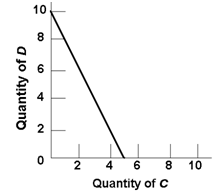Refer to the budget line illustrated in the diagram given. If the consumer's money income is $20, the: 1) prices of C and D cannot be determined.2) price of C is $2 and the price of D is $4. 3) consumer can obtain a combination of 5 units of both C and D. 4) price of C is $4 and the price of D is $2.
